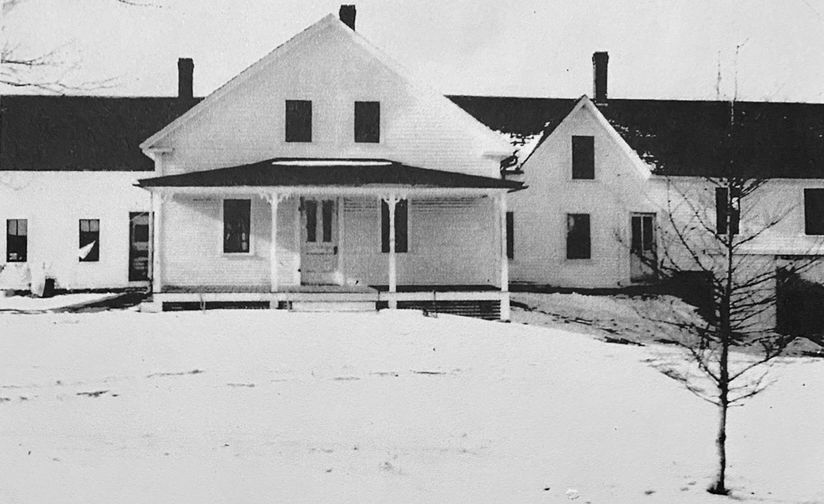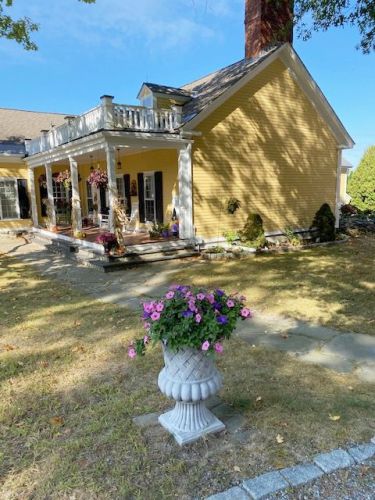New Boston Historical Society
New Boston, New Hampshire

Shown nearly 100 years ago, the home at 131 Hooper Hill had a traditional front porch then
and has been owned by the Mansfield Family as well as Roger Babson.
Behind the Door: 131 Hooper Hill Road
by Mary Atai (November 2020)
This land was owned by John Goodhue in 1796. He ran a dry goods store on the property for 20 years, before moving to Ohio. This was during the period when the center of town was organized around the top of Meetinghouse Hill. His son, Joseph married Betsy Felch and returned here in 1818. They had five children, and after his wife's passing, he remarried and had a daughter, Sarah Lucy Goodhue.
The Goodhues were a significant, well documented family. Sarah Lucy grew up to marry George Henry Mansfield. In 1870, they bought this farm, which was 91 acres at that time, from Sarah Lucy's brother, Amos Goodhue, for $4500. Three generations of Mansfields were born in this house. They farmed the land, raised pigs and cows, and took on the care of the adjacent cemetery land. The Mansfields have been a big part of the community and given much to the town for many, many years.
It is believed that George Henry Mansfield, Jr., son of Sarah Lucy and George Henry Sr. was the builder of the stone walls surrounding the cemetery. He farmed the land, and with his wife, Addie Jane Warren, had seven children. In the evening of August 26, 1939 George Henry walked up Meetinghouse Hill following a dance in the village. He was found dead in the morning, sitting on a cemetery wall, where he must have stopped to rest, facing the view of the western mountains.
His son, Paul, kept the farm going for some years. Paul and his wife, Martha Sargent Mansfield had three children. The New Boston Central School gymnasium is named after their son, Tom Mansfield, who was loved by the community and died suddenly in 1991. Tom's widow, Maureen, and his son, Tom, continue to add to the community.
Tom's sister, Mary Mansfield Waxman, has fond memories of the farm. She recalls that the kitchen was the center of their lives. There was a large wood stove where the baking and cooking was done. The wood box was refilled every night by the children. The iron teakettle was always on the stove. The sink was connected to a cold-water line, coming from a spring across the road, which froze up frequently in the winter. The outhouse was at the end of the building toward the barn and was very cold in the winter.
In 1948 the farm was sold to Roger W. Babson. He was an economist and is credited with predicting the great stock market crash in 1929. He also ran for president in 1940, coming in third behind Franklin Roosevelt and Wendell Wilkie. He had founded Babson College in Massachusetts in 1919 and ran a very successful company which gave stock market advice, called Babson Reports.
At M.I.T., Babson became very interested in gravity and felt it was possible to overcome it. He started the Gravity Research Foundation in the brick house in the center of town, now owned by Almus and Georgia Chancey. He bought many houses and much land here, feeling it was an ideal place to live, safely removed from possible atomic bomb threats to big cities.
Mr. Babson and his wife Grace chose this house to use as their private residence when they were in New Boston and immediately began to remodel. In 2016, Stephen Boulter, grandson of Artemus Boulter, who did the remodeling work, gifted the Historical Society with the very interesting detailed records and receipts from that remodel.
The house was eventually left to his grandson, Roger Babson Webber, an interior designer and antiques dealer. Roger re-created the formal parlor to an 18th century room. All the walls are paneled in wide native red pine, hand hewn. He also added a two-story 28 by 30 foot sunporch with three garages below. There is a "rainy day room" with a cathedral ceiling. Roger added hand hewn heavy ceiling beams in this room which he bought when the barn was torn down at 16 River Road.
Roger was well known and passed away unexpectedly at age 59 in 1984. There have been several owners since. We feel very fortunate to be the stewards now, maintaining this property for future generations.

Click here to return to the main page for "Behind the Door" articles.
